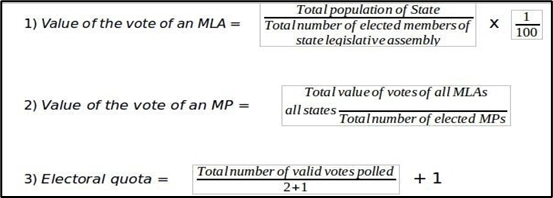Why in News?
On November 5, Americans will cast their ballots for their 47th president in the 60th quadrennial elections, primarily between Republican candidate and former President Donald Trump and Vice-President and Democrat Kamala Harris.
Rather than winning the popular vote, the U.S. Constitution stipulates that the winner is the candidate who clinches the most electoral college votes.
What’s in Today’s Article?
- What is the Electoral College?
- Structure of the Electoral College
- Arguments For and Against the Electoral College
- Electoral College for the Election of the President of India
What is the Electoral College?
- Meaning
- The Electoral College is a process through which the President and Vice President of the United States are indirectly
- The system involves three stages:
- Selection of electors by the popular vote.
- Voting by these electors for President and Vice President.
- Counting of electoral votes by Congress to determine the election outcome.
- Historical context and rationale for the Electoral College:
- The founding fathers debated two options:
- Congressional election of the President: Modelled on parliamentary systems, where the President would be elected by Congress.
- Direct popular vote: Preventing political collusion but potentially leading to dominance by populous states.
- The compromise was the Electoral College, intended as a balance to preserve state influence and prevent centralization.
Structure of the Electoral College:
- Total electors: The Electoral College consists of 538 electors, and a candidate needs 270 electoral votes to win the presidency.
- Elector distribution:
- Each state’s number of electors is equal to its congressional delegation (House members + two Senators).
- California, the largest state, has 54 electors, while small states like Alaska and Vermont have only three.
- Elector selection: Each political party nominates electors prior to the election, typically party members or affiliates.
- Electing the electors:
- On Election Day, voters in each state choose electors indirectly by voting for a presidential candidate.
- Most states have a "winner-takes-all" system, awarding all electoral votes to the candidate with the most popular votes.
- However, Maine and Nebraska use a proportional system, splitting electoral votes based on congressional district wins.
- Duties and voting by electors:
- Electors meet in December to formally vote for the President and Vice President.
- While electors traditionally vote in line with their party's candidate, there is no federal law binding them to do so.
- However, many states have laws enforcing elector loyalty, and faithless electors are rare, as seen in the 2016 election.
Arguments For and Against the Electoral College:
- For:
- Founders' intent: The Electoral College would ensure only highly qualified individuals would become President.
- National cohesiveness: Advocates argue it requires distribution of support across the country, preventing large states or cities from dominating.
- Criticisms:
- Vote disparity: Large states have disproportionate representation, as individual votes are less influential than in smaller states.
- Swing state focus: Candidates prioritise swing states, neglecting those where one party traditionally dominates.
- Faithless electors: The Electoral College often binds electors to party lines, counteracting its initial purpose of screening candidates.
- Conclusion:
- The Electoral College remains a contentious aspect of U.S. democracy.
- The debate over its relevance continues in the modern era, as advocates for reform push for a shift to direct elections.
Electoral College for the Election of the President of India:
- Constitutional basis:
- The Electoral College is established under Article 54 of the Indian Constitution.
- It provides a federal balance by giving states representation proportional to their populations while maintaining parity between the Union and the states.
- Composition: The Electoral College for the President’s election includes:
- Elected members of Parliament (MPs) from both the Lok Sabha (House of the People) and the Rajya Sabha (Council of States).
- Elected members of the Legislative Assemblies (MLAs) of all states and Union Territories with Legislative Assemblies (such as Delhi, Puducherry and J&K).
- Vote value:
- Voting method:
- The Single Transferable Vote (STV) system is used, which enables proportional
- Secret ballot is employed to maintain the confidentiality of the vote.
- Each elector casts a vote by ranking candidates in order of preference.
- Election process:
- A candidate must secure more than 50% of the total votes to win, which is referred to as an absolute majority.
- If no candidate achieves this majority in the first count, the candidate with the fewest votes is eliminated, and their votes are transferred based on subsequent preferences.
- This process continues until one candidate attains the required majority.
- Significance: This carefully designed system ensures that the President of India is chosen through a representative process that respects both the federal and democratic principles of the Constitution.










